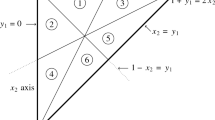Abstract
In scientific computations using floating point arithmetic, rescaling a data set multiplicatively (e.g., corresponding to a conversion from dollars to euros) changes the distribution of the mantissas, or fraction parts, of the data. A scale-distortion factor for probability distributions is defined, based on the Kantorovich distance between distributions. Sharp lower bounds are found for the scale-distortion of n-point data sets, and the unique data set of size n with the least scale-distortion is identified for each positive integer n. A sequence of real numbers is shown to follow Benford’s Law (base b) if and only if the scale-distortion (base b) of the first n data points tends zero as n goes to infinity. These results complement the known fact that Benford’s Law is the unique scale-invariant probability distribution on mantissas.
Similar content being viewed by others
References
Allaart, P.C.: An invariant-sum characterization of Benford’s law. J. Appl. Probab. 34, 288–291 (1997)
Benford, F.: The law of anomalous numbers. Proc. Am. Philos. Soc. 78, 551–572 (1938)
Berger, A., Morrison, K.E.: Best finite Kantorovich approximations (in preparation)
Bickel, P.J., Doksum, K.A.: Mathematical Statistics. Holden-Day, San Francisco (1976)
Billingsley, P.: Probability and Measure, 3rd edn. Wiley, New York (1995)
Chung, K.L.: A Course in Probability Theory, 2nd edn. Academic, New York (1974)
Dajani, K., Kraaikamp, C.: Carus Mathematical Monographs. Ergodic Theory of Numbers, vol. 29. Mathematical Association of America, Washington (2002)
Dudley, R.M.: Real Analysis and Probability. Wadsworth & Brooks/Cole Advanced Books & Software, Pacific Grove (1989)
Gibbs, A., Su, F.E.: On choosing and bounding probability metrics. Int. Stat. Rev. 70, 419–435 (2002)
Hill, T.P.: Base-invariance implies Benford’s law. Proc. Am. Math. Soc. 123, 887–895 (1995)
Hill, T.P.: A statistical derivation of the significant-digit law. Stat. Sci. 10, 354–363 (1995)
Knuth, D.E.: The Art of Computer Programming, volume 2: Seminumerical Algorithms, 2nd edn. Addison–Wesley, Reading (1981)
Newcomb, S.: Note on the frequency of use of the different digits in natural numbers. Am. J. Math. 4, 39–40 (1881)
Nigrini, M.: A taxpayer compliance application of Benford’s law. J. Am. Tax. Assoc. 1, 72–91 (1996)
Author information
Authors and Affiliations
Corresponding author
Additional information
The first author was partly supported by a Humboldt research fellowship. The second author was supported in part by the National Security Agency and as a Research Scholar in Residence at California Polytechnic State University.
Rights and permissions
About this article
Cite this article
Berger, A., Hill, T.P. & Morrison, K.E. Scale-Distortion Inequalities for Mantissas of Finite Data Sets. J Theor Probab 21, 97–117 (2008). https://doi.org/10.1007/s10959-007-0112-z
Received:
Revised:
Accepted:
Published:
Issue Date:
DOI: https://doi.org/10.1007/s10959-007-0112-z



